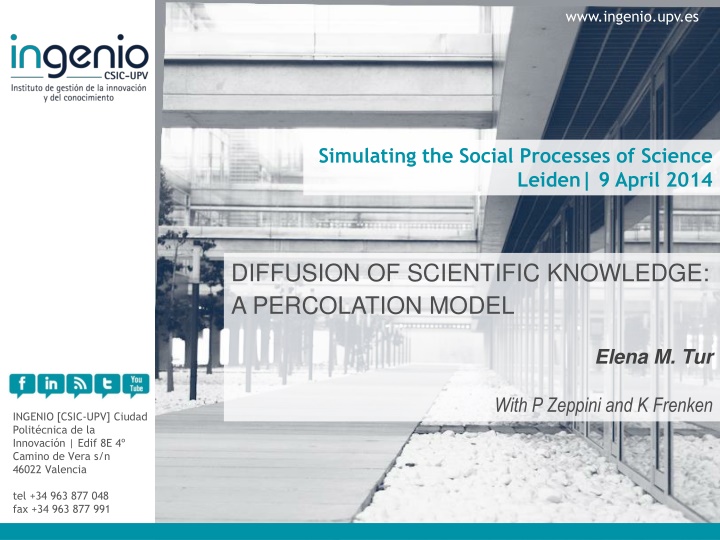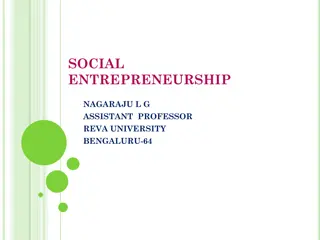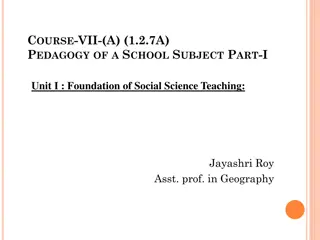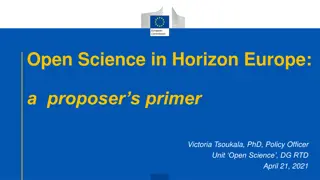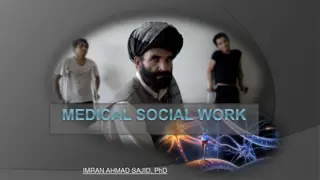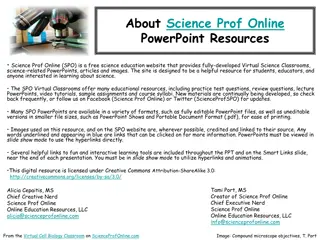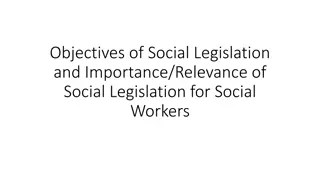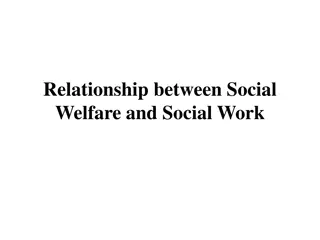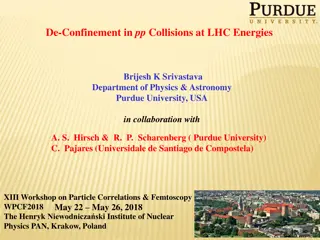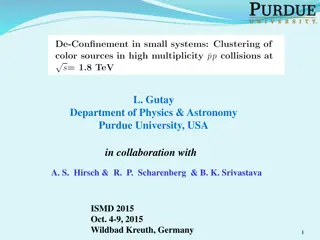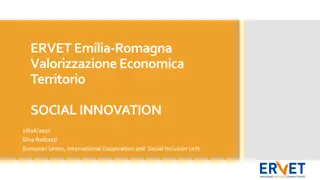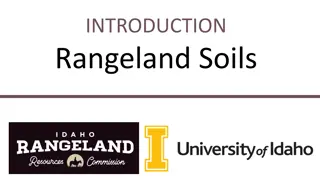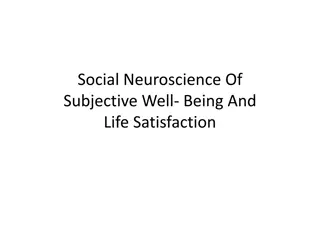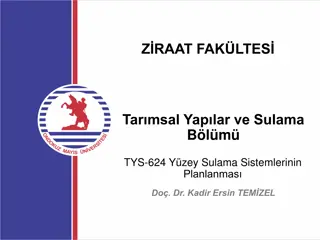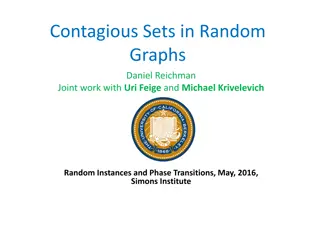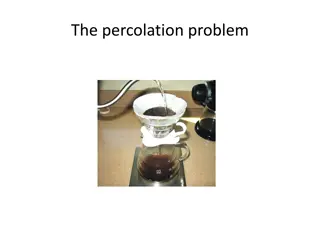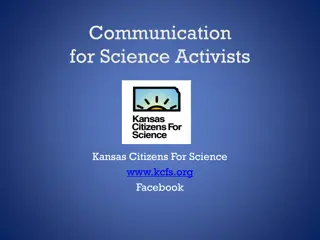Social Processes of Science: A Percolation Model
Exploring the diffusion of scientific knowledge through social networks, this study investigates the impact of social pressure and assortativity on the spread of ideas. With a focus on social dynamics and network structures, it delves into how local interactions influence global diffusion patterns. The research addresses the role of heterogeneity, externalities, and percolation in shaping the dissemination of information within communities. Through simulations and analysis, the study offers insights into paradigm shifts, opinion dynamics, and the online spread of behaviors in scientific contexts.
Uploaded on Oct 10, 2024 | 1 Views
Download Presentation

Please find below an Image/Link to download the presentation.
The content on the website is provided AS IS for your information and personal use only. It may not be sold, licensed, or shared on other websites without obtaining consent from the author.If you encounter any issues during the download, it is possible that the publisher has removed the file from their server.
You are allowed to download the files provided on this website for personal or commercial use, subject to the condition that they are used lawfully. All files are the property of their respective owners.
The content on the website is provided AS IS for your information and personal use only. It may not be sold, licensed, or shared on other websites without obtaining consent from the author.
E N D
Presentation Transcript
http://www.ferri.es/img/menu_sup/falsa.gif http://www.ferri.es/img/menu_sup/falsa.gif http://www.ferri.es/img/menu_sup/falsa.gif http://www.ferri.es/img/menu_sup/falsa.gif http://www.ferri.es/img/menu_sup/falsa.gif http://www.ferri.es/img/menu_sup/falsa.gif http://www.ferri.es/img/menu_sup/falsa.gif www.ingenio.upv.es Simulating the Social Processes of Science Leiden| 9 April 2014 DIFFUSION OF SCIENTIFIC KNOWLEDGE: A PERCOLATION MODEL Elena M. Tur With P Zeppini and K Frenken INGENIO [CSIC-UPV] Ciudad Polit cnica de la Innovaci n | Edif 8E 4 Camino de Vera s/n 46022 Valencia tel +34 963 877 048 fax +34 963 877 991
Focus How do social pressure and assortativity affect the process of diffusion? How do their effect interact with the social network structure? How do local effects dictate global diffusion through the overall network structure? Main contribution: introducing social pressure in a model of diffusion with different network structures 2 2
Diffusion of ideas Spread of rumors (Zanette, 2002) Online spreading of behavior (Centola, 2010) Opinion dynamics (Shao et al., 2009) Paradigm shift in science (Brock and Durlauf, 1999) How to approach the problem (Zeppini and Frenken, 2013) Heterogeneity of agents Externalities Social network Percolation (Solomon et al., 2000) 3
Percolation in a social network ?0 [0,1]: value of the idea ??: minimum quality requirement of agent ? Agent ? adopts the idea at time ? if: ? has not adopted before ? ? is informed: a neighbor has adopted at time ? 1 ? is willing to adopt: ?? ?0 4
Percolation in a social network ?? ? 0,1 ?? ?0 ? 5
Social network Small world (Watts and Strogatz, 1998) Starting with a regular lattice, with ? nodes and ? edges per node, rewire each edge at random with probability ? High clustering coefficient, low average path length 7
Percolation without social pressure Upper bound to diffusion: 45 line (well-mixed population) Diffusion increases with ? Phase changes: from a non-diffusion to a diffusion regime Percolation thresholds decrease with ? 8
Why social pressure? The unwilling to adopt can be persuaded Network externalities: shared language, shared experiences, shared beliefs Increasing amount of evidence Conformity (Asch,1958) Weariness 10
Modelling social Pressure ?: # neighbors of agent ? that have adopted at time ? ?? ?: social pressure intensity ? 1 ? ???= ?0 ? ?? ???is decreasing in the number of adopting neighbors ??? is decreasing in the social pressure intensity ???= ?0 ???= ?0 ? if ? = 0 ? if ?? ?= 1 11
Parameters for the simulations ? = 10,000 agents ? = 4 original neighbors in the small world algorithm 10 seeds or original adopters ? = 1,000 time periods ? = 20 runs of Monte Carlo simulations ?0 [0,1] ?? ?[0,1]iid ? 0,1 Social networks: lattice, small world, Poisson network 12 12
ASSORTATIVITY People tend to be friends with similar people 16
Modelling assortativity Most unwilling to adopt Most willing to adopt 17
Percolation with assortativity No critical transition from non-diffusion to diffusion Diffusion size scales linearly with diffusion size No effect of the network structure (well-mixed population) 18
CONCLUSIONS 22
Conclusions Social pressure changes the behavior of the percolation process: higher diffusion size, lower percolation thresholds The effect of social pressure is different for different network structures: critical transition in small worlds and lattices With social pressure, clustering becomes beneficial for diffusion: reduced differences between networks Assortativity removes the effect of the network structure: all behave as a well-mixed population Assortativity can help or hamper diffusion depending on the setting 23
Future work and limitations Other social network structures: scale-free networks (Bar basi and Albert, 1999) Evolving endogenous social network Re-think the social pressure implementation: always possitive efffect? Different minimum quality requirement distributions, ????(?,?) 24
THANK YOU INGENIO [CSIC-UPV] Ciudad Polit cnica de la Innovaci n | Edif 8E 4 Camino de Vera s/n 46022 Valencia tel +34 963 877 048 fax +34 963 877 991 25
